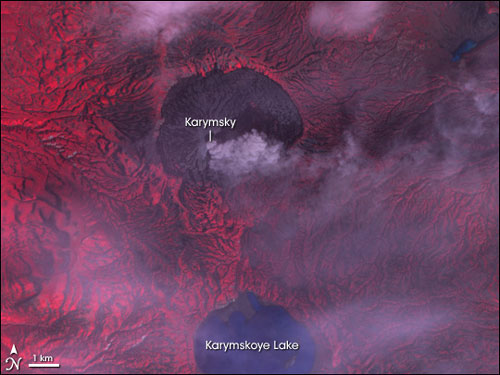It was noted in this story about increasing seismic and thermal activity at Bezymianny volcano on the Kamchatka Peninsula that two other volcanoes had been continuously active in this region for the past 11 years or so. My interest was piqued enough to check out the Nasa Earth Observatory, where I found this fabulous image of the ash plume rising from one of these, Shiveluch, in a recent eruption (click on the image for the source page):
What’s so great about this image is that it shows the plume after it has risen high into the atmosphere, but before it has been disrupted and blown away from the volcano by winds; this is what has happened in this admittedly slightly less impressive image from the other active volcano, Karymsky:
These volcanoes are part of the Pacific ‘Ring of Fire’: almost the whole edge of the Pacific Plate between Chile and New Zealand, through Alaska, west Russia and Japan, is being subducted and releasing water into the mantle beneath the various over-riding plates, causing the mantle rocks to melt and producing large numbers of volcanoes. Magma produced this way tends to be quite gassy, resulting in quite explosive (and therefore dangerous) eruptions – throwing ash clouds high up into the air and producing dangerous pyroclastic flows, rather than slow and oozy lava. Fortunately, Kamchatka is quite sparsely populated, although in keeping with our species’ usual respect for geology, they’ve parked the major city in the region on the slopes of another historically active volcano, Avachinsky.
I really should check out the Earth Observatory more often – they put out some really nice imagery.





Comments (1)